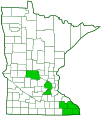Japanese hop
(Humulus japonicus)
Conservation • Weed • Wetland • Description • Habitat • Ecology • Use • Distribution • Taxonomy
Description |
||
Japanese hop is a annual vine that rises from a long taproot. It can form dense mats several feet deep covering all other vegetation. The stem is stout, non-woody, light green, and branched. It is solid at maturity and usually finely ridged or angled. It is rough and prickly to the touch, and is densely covered with stiff, 2-branched hairs on the ridges. Each hair has two rigid branches that spread in opposite directions. These hairs facilitate climbing by anchoring the vine to adjacent plants or structures. The stem is hairiest at the nodes, and is hairless or minutely hairy between the branched hairs. It climbs by turning clockwise at the tip (twining). Charles Darwin observed that it made a complete revolution every 128 minutes during daytime in hot weather. Leaves are opposite, broadly egg-shaped in outline, and heart-shaped at the base. They are on 1¾″ to 8″ long leaf stalks (petioles). The petioles are as long or longer than the leaf blades. They are sometimes twining and are sparsely to moderately covered with stiff, 2-branched hairs. At the base of each leaf is a pair of lance-shaped, leaf-like appendages (stipules). The stipules are sometimes fused, appearing as a single stipule. Leaf blades are 1¼″ to 6″ long, and 1½″ to 7″ wide. They are palmately divided into usually 5 lobes, sometimes 7 or 9 lobes. The lobes are broadly to narrowly egg-shaped, taper to a sharp point at the tip, and are somewhat narrowed at the base. The upper surface of the leaf blade is rough to the touch and is sparsely covered with stiff, prickly hairs. The lower surface is rough to the touch. It is sparsely to moderately covered with stiff, spreading, bulbous-based hairs along the veins, and is hairless but has yellow glands between the veins. The margins have sharp, forward pointing teeth and stiff, prickly, bulbous-based hairs. Male and female flowers are borne on separate plants. The male inflorescence is loose, erect, branched cluster (panicle) of 20 to 100 or more flowers at the end of the stem and rising from leaf axils. The panicles are 6″ to 10″ long, and ¾″ to 1½″ wide. The female inflorescence is a pair of dense, cone-shaped, ⅜″ to ¾″ long spikes (aments) drooping from leaf axils. The ament consists of overlapping, dull, pale green bracts. Male flowers are star shaped, 1 ⁄32″ to ⅛″ long, and about ¼″ wide. There are 5 reddish sepals, no petals, and 5 stamens. The anthers are not glandular. Female flowers consist of an ovary with a long, slender stigma. They are paired between overlapping bracts of the ament. The ament elongates when in fruit, becoming ⅝″ to 1 3 ⁄16″ long. The bracts are ¼″ to ½″ long, egg-shaped to broadly egg-shaped, densely hairy along the margins, and sparsely to moderately hairy on the outer surface. They are not glandular. The fruit is a light brown to yellowish-brown, broadly egg-shaped to nearly spherical, ⅛″ to 3 ⁄16″ long, 1 ⁄16″ to ⅛″ wide seed capsule (achene) enclosed in a persistent, enlarged calyx and covered by a papery bract. It is not glandular. |
||
Height |
||
Vine: 20″ to 16′ or more in length |
||
Flower Color |
||
Pale green (female) and reddish (male) |
||
Similar Species |
||
| Common hop (Humulus lupulus) leaf blades have usually 3, occasionally 5 lobes, and sometimes no lobes on leaves near the end of the vine. The underside is hairless or softly hairy, soft to the touch. The petioles are shorter than the leaf blade. The bracts on the ament do not have hairs on the margins. The outer surface of the bracts, the anthers, and the achenes have stalked glands. The fruit structure is fragrant when crushed due to these glands. | ||
Habitat |
||
Moist. Bottomland prairies, bottomland forest edges, banks of streams and rivers, roadside ditches, disturbed areas. Full sun. Rich soil. |
||
Ecology |
||
Flowering |
||
July to August |
||
Pests and Diseases |
||
|
||
Use |
||
|
||
Distribution |
||||
|
Sources |
|||
| 3/18/2023 | ||||
Nativity |
||||
Native to Asia and Vietnam. Introduced and escaped cultivation. Now naturalized in North America. |
||||
Occurrence |
||||
Rare in Minnesota. Established in extreme southeastern counties, adventive elsewhere. |
||||
Taxonomy |
|||
| Kingdom | Plantae (green algae and land plants) | ||
| Subkingdom | Viridiplantae (green plants) | ||
| Infrakingdom | Streptophyta (land plants and green algae) | ||
| Superdivision | Embryophyta (land plants) | ||
| Division | Tracheophyta (vascular plants) | ||
| Subdivision | Spermatophytina (seed plants) | ||
| Class | Magnoliopsida (flowering plants) | ||
| Superorder | Rosanae | ||
Order |
Rosales (roses, elms, figs, and allies) | ||
Family |
Cannabaceae (hackberry) | ||
Genus |
Humulus (hops) | ||
Subordinate Taxa |
|||
|
|||
Synonyms |
|||
Humulus scandens |
|||
Common Names |
|||
Japanese hop Japanese hops |
|||
Hop or Hops?
Both “hop” and “hops” are correct common names for Humulus lupulus. The word “hop” can refer to the plant itself, the female flowers of the plant, or the dried female flowers that are used to flavor beer. The plural form “hops” is often used to refer to the dried female flowers.
Glossary
Achene
A dry, one-chambered, single-seeded seed capsule, formed from a single carpel, with the seed attached to the membranous outer layer (wall) only by the seed stalk; the wall, formed entirely from the wall of the superior ovary, does not split open at maturity, but relies on decay or predation to release the contents.
Ament
A cylinder-shaped, spike-like inflorescence bearing unisexual flowers that have no petals.
Axil
The upper angle where a branch, stem, leaf stalk, or vein diverges.
Bract
Modified leaf at the base of a flower stalk, flower cluster, or inflorescence.
Calyx
The group of outer floral leaves (sepals) below the petals, occasionally forming a tube.
Palmate
Similar to a hand. Having more than three lobes or leaflets that radiate from a single point at the base of the leaf.
Panicle
A pyramidal inflorescence with a main stem and branches. Flowers on the lower, longer branches mature earlier than those on the shorter, upper ones.
Petiole
The stalk of a leaf blade or compound leaf that attaches the leaf blade to the stem.
Sepal
An outer floral leaf, usually green but sometimes colored, at the base of a flower.
Stipule
A small, leaf-like, scale-like, glandular, or rarely spiny appendage found at the base of a leaf stalk, usually occurring in pairs and usually dropping soon.
Twining
Growing in a spiral usually around a stem of another plant that serves as support.
Visitor Photos |
|||||
Share your photo of this plant. |
|||||
| This button not working for you? Simply email us at info@MinnesotaSeasons.com. Attach one or more photos and, if you like, a caption. |
|||||
|
|||||
MinnesotaSeasons.com Photos |
|||||
Plant |
|||||
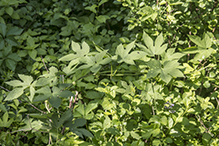 |
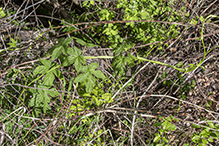 |
||||
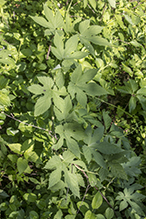 |
|||||
Leaves |
|||||
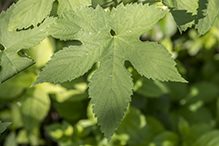 |
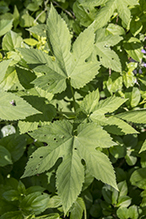 |
||||
Stem and Petioles |
|||||
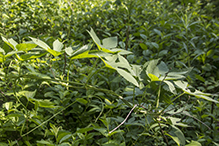 |
|||||
Japanese hop (top) and common hop (bottom) |
|||||
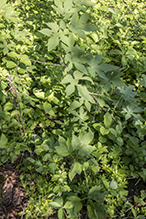 |
|||||

Slideshows |
||

Visitor Videos |
|||
Share your video of this plant. |
|||
| This button not working for you? Simply email us at info@MinnesotaSeasons.com. Attach a video, a YouTube link, or a cloud storage link. |
|||
Other Videos |
|||
| Japanese Hop, identification of the Wisconsin Invasive Species Humulus japonicas University of Wisconsin Extension |
|||
About
Published on Jul 26, 2011 This is part of a series of videos providing key characteristics for the identification of invasive plants listed in Wisconsin's invasive species administrative rule NR 40. These videos are produced by Dr. Mark Renz of the University of Wisconsin-Madison. For more information on invasive plants and invasive plant management in Wisconsin visit http://fyi.uwex.edu/weedsci |
|||
| Riparean Forests + Japanese Hop Sarah Lancry |
|||
About
Published on Jun 6, 2016 This video is about the affect Japanese Hop (an invasive species) has on riparean forest's. |
|||
| BEES COLLECTING POLLEN FROM JAPANESE HOPS Ellen McGlynn |
|||
About
Published on Sep 2, 2012 Bees collecting pollen from Japanese Hops (Humulus japonicus) at Big Bear Bee Farm, Clarks Summit, PA. 9/2/2012 |
|||

Visitor Videos |
|||
Share your video of this plant. |
|||
| This button not working for you? Simply email us at info@MinnesotaSeasons.com. Attach a video, a YouTube link, or a cloud storage link. |
|||
Other Videos |
|||
| Japanese Hop, identification of the Wisconsin Invasive Species Humulus japonicas University of Wisconsin Extension |
|||
About
Published on Jul 26, 2011 This is part of a series of videos providing key characteristics for the identification of invasive plants listed in Wisconsin's invasive species administrative rule NR 40. These videos are produced by Dr. Mark Renz of the University of Wisconsin-Madison. For more information on invasive plants and invasive plant management in Wisconsin visit http://fyi.uwex.edu/weedsci |
|||
| Riparean Forests + Japanese Hop Sarah Lancry |
|||
About
Published on Jun 6, 2016 This video is about the affect Japanese Hop (an invasive species) has on riparean forest's. |
|||
| BEES COLLECTING POLLEN FROM JAPANESE HOPS Ellen McGlynn |
|||
About
Published on Sep 2, 2012 Bees collecting pollen from Japanese Hops (Humulus japonicus) at Big Bear Bee Farm, Clarks Summit, PA. 9/2/2012 |
|||

|
Created: Last Updated: © MinnesotaSeasons.com. All rights reserved. |
